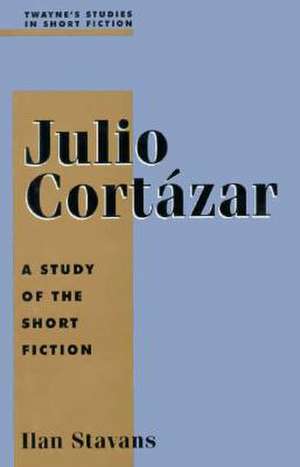Studies in Short Fiction Series: Julio Cortazar: Twayne's Studies in Short Fiction, cartea 63
Autor Ilan Stavansen Limba Engleză Hardback – 31 ian 1996
Din seria Twayne's Studies in Short Fiction
-
 Preț: 350.47 lei
Preț: 350.47 lei -
 Preț: 436.17 lei
Preț: 436.17 lei -
 Preț: 435.60 lei
Preț: 435.60 lei -
 Preț: 351.99 lei
Preț: 351.99 lei -
 Preț: 351.77 lei
Preț: 351.77 lei -
 Preț: 350.08 lei
Preț: 350.08 lei -
 Preț: 353.52 lei
Preț: 353.52 lei -
 Preț: 356.22 lei
Preț: 356.22 lei -
 Preț: 350.85 lei
Preț: 350.85 lei -
 Preț: 353.90 lei
Preț: 353.90 lei -
 Preț: 351.00 lei
Preț: 351.00 lei -
 Preț: 352.76 lei
Preț: 352.76 lei -
 Preț: 478.53 lei
Preț: 478.53 lei -
 Preț: 459.07 lei
Preț: 459.07 lei - 23%
 Preț: 428.84 lei
Preț: 428.84 lei -
 Preț: 454.26 lei
Preț: 454.26 lei -
 Preț: 457.54 lei
Preț: 457.54 lei -
 Preț: 456.77 lei
Preț: 456.77 lei -
 Preț: 455.79 lei
Preț: 455.79 lei -
 Preț: 459.48 lei
Preț: 459.48 lei -
 Preț: 457.54 lei
Preț: 457.54 lei -
 Preț: 453.67 lei
Preț: 453.67 lei -
 Preț: 479.50 lei
Preț: 479.50 lei
Preț: 288.71 lei
Nou
Puncte Express: 433
Preț estimativ în valută:
55.24€ • 57.68$ • 45.62£
55.24€ • 57.68$ • 45.62£
Carte indisponibilă temporar
Doresc să fiu notificat când acest titlu va fi disponibil:
Se trimite...
Preluare comenzi: 021 569.72.76
Specificații
ISBN-13: 9780805782936
ISBN-10: 0805782931
Pagini: 188
Dimensiuni: 148 x 222 x 20 mm
Greutate: 0.35 kg
Ediția:New.
Editura: Twayne Publishers
Seria Twayne's Studies in Short Fiction
ISBN-10: 0805782931
Pagini: 188
Dimensiuni: 148 x 222 x 20 mm
Greutate: 0.35 kg
Ediția:New.
Editura: Twayne Publishers
Seria Twayne's Studies in Short Fiction
Textul de pe ultima copertă
A story, Julio Cortazar claimed, is born in a sparkle, a thunderous strike of inspiration, and requires very little by way of processing. He considered literature the product of a spirit dictating its craft to numerous scribes everywhere on the globe; his unusual methods of writing short stories was not unlike those developed by the French surrealist Andre Breton and the American Beat writer Jack Kerouac. Author of the internationally acclaimed novel Hopscotch (1963), Cortazar was born in Brussels, raised in Buenos Aires, and self-exiled to Europe in 1951. Although very much in vogue in the 1960s and 1970s in Europe, the United States, and Latin America, Cortazar has mysteriously fallen out of public favor since his death in 1984. In this volume Ilan Stavans seeks to redress this neglect, using Cortazar's art to enlighten his life and vice versa. He focuses his analysis on the ways in which, by choosing to rebuff, imitate, or pay homage to Jorge Luis Borges, Edgar Allan Poe, and other writers, Cortazar found his own unique style. Stavans argues that a handful of the hundred or so stories Cortazar wrote are among the best this century has delivered, including "Axolot!" (1956), about a man trapped in the body of a salamander; "House Taken Over" (1946), about the effects of tyranny on individual freedom and domestic life; and "Blow-Up" (1958), about the moral implications that emerge after one witnesses a crime. Stavans begins by studying Cortazar's artistic development as a writer in Buenos Aires from the early 1940s until 1951; he then analyzes what the Argentine wrote in Paris and traces his favorite themes and symbols, paying special attention to his long story "The Pursuer (1958), considered by many to be a transitional work. He also examines Cortazar's ideological commitment during the student uprising in Paris in 1968, his views on the Cuban Revolution and the Sandinistas in Nicaragua, and his so-called ideological stories. The second section of this volume reprints what Stavans considers Cortazar's best explanation of what makes a short story unique and what its uses are - "On the Short Story and Its Environs" - along with two personal essays, "The Present State of Fiction in Latin America" and "Letter to Roberto Fernandez Retamar," which clarify Cortazar's method of writing, his aesthetic approach to the natural and supernatural, and his view on the role artists and intellectuals are called upon to play in Third World. In the third section, an essay by critic John Ditski studies Cortazar's early works, while a piece by Evelyn Picon Garfield, a longtime Cortazar devotee and the author of an insightful book-length interview with him, focuses on Octahedron (1974).
